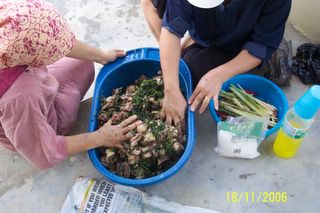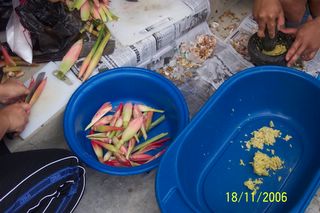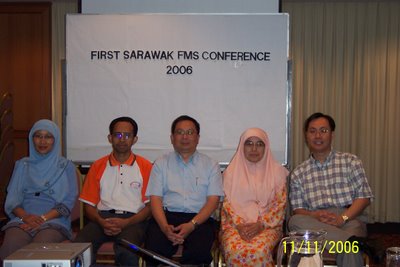 I was elated when my name was short-listed to accompany Dato Dr. Shafei Oyub for his pre-retirement pan
I was elated when my name was short-listed to accompany Dato Dr. Shafei Oyub for his pre-retirement pan The only way to Kapit and Belaga is by express boat through the liquid highway of the mighty Rajang river. The elongated twin horse engines express boat measured approximately 15 meters long offered 3 different categories of sit ; the first, second and third class. A fully air-conditioned cabin with a large screen TV at the front provides a comfortable and relaxing journey. There are several trips going upstream, the last trip is at
We started our journey from the Sibu wharf by taking the afternoon express boat towards Kapit. The plan was to spend a night in Kapit and proceed to Belaga the next day. From Kapit another group of MOH delegate would join us to Belaga.
It takes 3 - 4 hours from Sibu to Kapit and another 5 - 6 hours from Kapit to Belaga depends on how frequent the express boat stop to disembark people of the long house to their home which scattered along the river.
At the distance I caught sight of the log-loading station at one side of the riverbank. I couldn’t help but felt upset to see the bulldozers and huge lumber trucks moved back and forth over the large clearing, arranging the giant logs. The barren ground was soaked with sump oil to keep down the dust and raw, red earth logging roads radiated into the denuded hillsides.

Three hours later we reached the Kapit town. As the defeaning roar of the engine ceased away it nestled in adjacent and parallel with half a dozen similar boats. We have to walk cautiously on the edge of the adjacent boat before able to step on the concrete building of the wharf.
Kapit is the homeland of Iban. It is the largest division in

That evening I have a separate agenda at the Kapit Health Clinic while Dato Shafei and the rest of the team went straight to the Sri Balleh government rest house on the top of the hill overlooking the Kapit town where we spent the night.
Almost every year the rapid claims human soul. Early this year a school teacher from the interior school died after been accidentally thrown away by the wobbly boat into the rapids while he was enjoying the view on the roof of the express boat.
That morning after the dawn prayer I took a walk around the rest house. The extensive spectacular panorama of the greeny mountains and the slow moving river filled my heart with melancholy. I realized that I have strong feeling towards the river, the mountains, the forest and the surrounding people.

A few hours later the only express boat to Belaga arrived from Sibu. Unfortunately (or rather fortunate) the inner cabin was full with passengers and only few of them alighted to end their journey in Kapit. As a result most of us have to take a sit on the roof-top.

I secured a place in between those stuffs near to the roaring engine to give me enough handle to grip should the boat swayed. The overwhelmed excitement overcomes my sense of fear as the express boat speeding upstream. I anticipated the ‘Lost World’ of Arthur Conan Doyle and forgot the dangerous man-swallowing rapids.
Sitting on the roof was actually a perfect place to enjoy the beautiful panorama of the rainforest. The blue sky on the top combined with the murky yellow river at the bottom and the greeny mountains on both sides gave you an almost surreal landscape. I was hypnotized by those wonderful views and forgot the burning skin of my forehead due to the scorching
 A few hours later we reached the most dangerous spot. As we were approaching the Pelagus rapids I could see a warning signboard on the riverside alerting the boat passengers to put on their safety jacket. Amazingly I could not find a single safety jacket available for the passengers inside the boat let alone for the extra passengers on the roof-top.
A few hours later we reached the most dangerous spot. As we were approaching the Pelagus rapids I could see a warning signboard on the riverside alerting the boat passengers to put on their safety jacket. Amazingly I could not find a single safety jacket available for the passengers inside the boat let alone for the extra passengers on the roof-top.The slow moving water suddenly became a terrifying tumultuous turbulence. As the express boat lurched and rolled it way through the boiling rapids I strengthened my grab on the handle while my mouth keeps repeating the Noah prayer. I could felt my adrenaline flows freely as the river and my entire system was fully charged for fight or flight should any bad things happened. But thanks God we managed to cruise through the treacherous rapids safely. The initial terrifying feeling later became an exhilarating experience.
WATCH PELAGUS RAPIDS IN ACTION
We reached Belaga six hours later. The Belaga folks welcomed us with the traditional Kenyah dance. Belaga is such a small town. It has only few rows of shop houses, budget inns, a health clinic and a post office in one small area. Belaga grew up in the early 1900s when a few Chinese traders set up shops and started trading with the upriver people, supplying essentials such as kerosene, salt and cooking utensils.
During dinner there was a big welcome party. Dressed in their traditional costume a group of Kayan ladies performed their traditional dance followed by a solo dance of ‘ngajat’ in synchronize with the background traditional music. Later on, in his speech Dato Shafei thanked the Belaga people for their warm hospitality and reassured them that the new clinic will becomes a reality soon. The party continued with a karaoke session (a compulsory session for the Sarawakian during any party) and it end up an hour before
At dawn I was awakened by the chorus of azan from the nearby mosque. After having a light breakfast we caught an early express boat back to Sibu. A brief visit to this remote area of

























